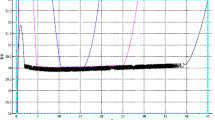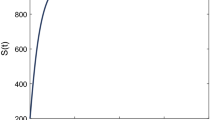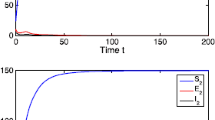Abstract
In this paper, we consider a delayed diffusive SVEIR model with general incidence. We first establish the threshold dynamics of this model. Using a Nonstandard Finite Difference (NSFD) scheme, we then give the discretization of the continuous model. Applying Lyapunov functions, global stability of the equilibria are established. Numerical simulations are presented to validate the obtained results. The prolonged time delay can lead to the elimination of the infectiousness.
Similar content being viewed by others
Explore related subjects
Discover the latest articles and news from researchers in related subjects, suggested using machine learning.References
Kribs-Zaleta C M, Velasco-Hernández J X. A simple vaccination model with multiple endemic states. Mathematical Biosciences, 2000, 164(2): 183–201
Arino J, McCluskey C C, van den Driess P. Global results for an epidemic model with vaccination that exhibits backward bifurcation. SIAM Journal on Applied Mathematics, 2003, 64(1): 260–276
Li J, Ma Z, Zhou Y. Global analysis of SIS epidemic model with a simple vaccination and multiple endemic equilibria. Acta Mathematica Scientia, 2006, 26B(1): 83–93
Liu X, Takeuchi Y, Iwami S. SVIR epidemic models with vaccination strategies. Journal of Theoretical Biology, 2008, 253(1): 1–11
Li J, Yang Y. SIR-SVS epidemic models with continuous and impulsive vaccination strategies. Journal of Theoretical Biology, 2011, 280(1): 108–116
Zhu Q, Hao Y, Ma J, Yu S, Wang Y. Surveillance of hand, foot, and mouth disease in mainland china (2008–2009). Biomedical and Environmental Sciences, 2011, 24(4): 349–356
Martcheva M. Avian flu: modeling and implications for control. Journal of Biological Systems, 2014, 22(1): 151–175
Wang W, Ruan S. Simulating the SARS outbreak in beijing with limited data. Journal of Theoretical Biology, 2004, 227(3): 369–379
Liljeros F, Edling C R, Amaral L A N. Sexual networks: implications for the transmission of sexually transmitted infections. Microbes and Infection, 2003, 5(2): 189–196
Liu W M, Levin S A, Iwasa Y. Influence of nonlinear incidence rates upon the behavior of SIRS epidemiological model. Journal of Mathematical Biology, 1986, 23(2): 187–204. 18
Capasso V, Serio G. A generalization of the Kermack-McKendrick deterministic epidemic model. Mathematical Biosciences, 1978, 42(1/2): 43–61
Hattaf K, Lashari A A, Louartassi Y, Yousfi N. A delayed SIR epidemic model with general incidence rate. Electronic Journal of Qualitative Theory of Differential Equations, 2013(3): 1–9
Wang L, Liu Z, Zhang X. Global dynamics of an SVEIR epidemic model with distributed delay and nonlinear incidence. Applied Mathematics and Computation, 2016, 284: 47–65
Hattaf K. Global stability and Hopf bifurcation of a generalized viral infection model with multi-delays and humoral immunity. Physica A: Statal Mechanics and its Applications, 2020, 545: 123689
Wang J, Huang G, Takeuchi Y, Liu S. SVEIR epidemiological model with varying infectivity and distributed delays. Mathematical Biosciences and Engineering, 2011, 8(3): 875–888
Xu R. Global stability of a delayed epidemic model with latent period and vaccination strategy. Applied Mathematical Modelling, 2012, 36(11): 5293–5300
Duan X, Yuan S, Li X. Global stability of an SVIR model with age of vaccination. Applied Mathematics and Computation, 2014, 226: 528–540
Meng X, Chen L, Wu B. A delay SIR epidemic model with pulse vaccination and incubation times. Nonlinear Analysis: Real World Applications, 2010, 11(1): 88–98
Gao S, Chen L, Nieto J J, Torres A. Analysis of a delayed epidemic model with pulse vaccination and saturation incidence. Vaccine, 2006, 24(35/36): 6037–6045
Zhang T, Zhang T Q, Meng X. Stability analysis of a chemostat model with maintenance energy. Applied Mathematics Letters, 2017, 68: 1–7
Zhang T, Liu X, Meng X, Zhang T Q. Spatio-temporal dynamics near the steady state of a planktonic system. Computers and Mathematics with Applications, 2018, 75(12): 4490–4504
Hattaf K, Yousfi N. Global stability for reaction-diffusion equations in biology. Computers Mathematics with Applications, 2013, 66(8): 1488–1497
Webby R J, Webster R G. Are we ready for pandemic influenza? Science, 2003, 302: 1519–1522
Xu Z, Ai C. Traveling waves in a diffusive influenza epidemic model with vaccination. Applied Mathematical Modelling, 2016, 40(15/16): 7265–7280
Abdelmalek S, Bendoukha S. Global asymptotic stability of a diffusive SVIR epidemic model with immigration of individuals. Electronic Journal of Differential Equations, 2016, 2016(129/324): 1–14
Xu Z, Xu Y, Huang Y. Stability and traveling waves of a vaccination model with nonlinear incidence. Computers and Mathematics with Applications, 2018, 75(2): 561–581
Mickens R E. Nonstandard Finite Difference Models of Differential Equations. World Scientific, December 1993
Arenas A J, Morano J A, Cortés J C. Non-standard numerical method for a mathematical model of RSV epidemiological transmission. Computers and Mathematics with Applications, 2008, 56(3): 670–678
Hattaf K, Yousfi N. Global properties of a discrete viral infection model with general incidence rate. Mathematical Methods in the Applied Sciences, 2016, 39(5): 998–1004
Hattaf K, Yousfi N. A numerical method for delayed partial differential equations describing infectious diseases. Computers and Mathematics with Applications, 2016, 72(11): 2741–2750
Liu J, Peng B, Zhang T. Effect of discretization on dynamical behavior of SEIR and SIR models with nonlinear incidence. Applied Mathematics Letters, 2015, 39: 60–66
Muroya Y, Bellen A, Enatsu Y, Nakata Y. Global stability for a discrete epidemic model for disease with immunity and latency spreading in a heterogeneous host population. Nonlinear Analysis: Real World Applications, 2013, 13(1): 258–274
Qin W, Wang L, Ding X. A non-standard finite difference method for a hepatitis B virus infection model with spatial diffusion. Journal of Difference Equations and Applications, 2014, 20(12): 1641–1651
Geng Y, Xu J. Stability preserving NSFD scheme for a multi-group SVIR epidemic model. Mathematical Methods in the Applied Sciences, 2017, 40(13): 4917–4927
Ding D, Ma Q, Ding X. A non-standard finite difference scheme for an epidemic model with vaccination. Journal of Difference Equations and Applications, 2013, 19(2): 179–190
Yang Y, Zhou J, Ma X, Zhang T. Nonstandard finite difference scheme for a diffusive within-host virus dynamics model with both virus-to-cell and cell-to-cell transmissions. Computers and Mathematics with Applications, 2016, 72(4): 1013–1020
Zhou J, Yang Y, Zhang T. Global dynamics of a reaction-diffusion waterborne pathogen model with general incidence rate. Journal of Mathematical Analysis and Applications, 2018, 466(1): 835–859
Martin R H, Smith H L. Abstract functional differential equations and reaction-diffusion systems. Transactions of the American Mathematical Society, 1990, 321(1): 1–44
Fujimoto T, Ranade R R. Two characterizations of inverse-positive matrices: the Hawkins-Simon condition and the Le Chatelier-Braun principle. The Electronic Journal of Linear Algebra, 2004, 11: 59–65
Author information
Authors and Affiliations
Corresponding author
Rights and permissions
About this article
Cite this article
Zhou, J., Ma, X., Yang, Y. et al. A Diffusive Sveir Epidemic Model with Time Delay and General Incidence. Acta Math Sci 41, 1385–1404 (2021). https://doi.org/10.1007/s10473-021-0421-9
Received:
Revised:
Published:
Issue Date:
DOI: https://doi.org/10.1007/s10473-021-0421-9




